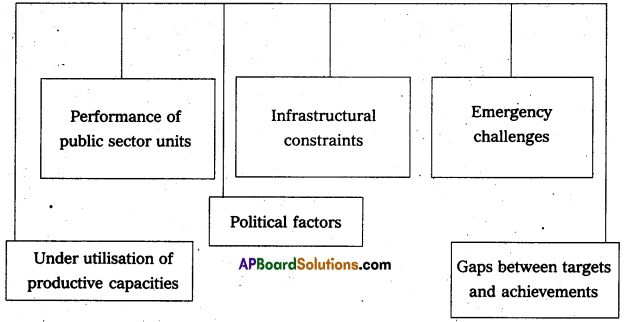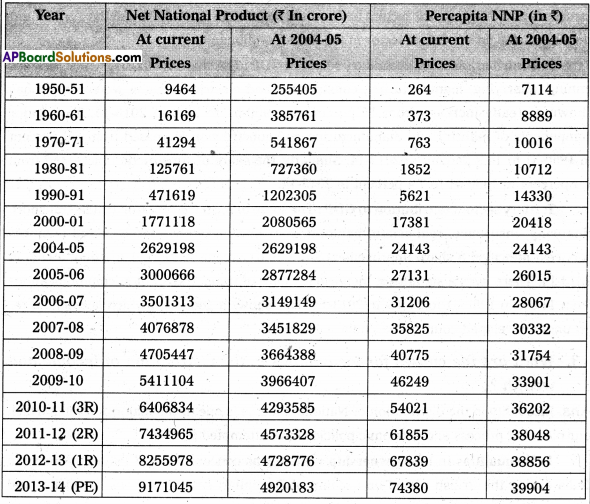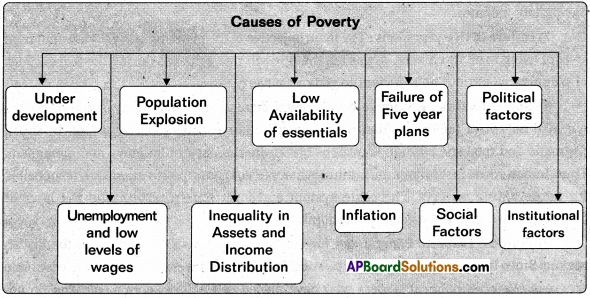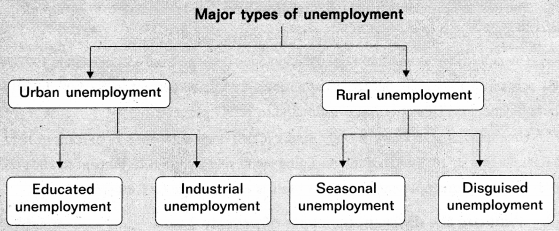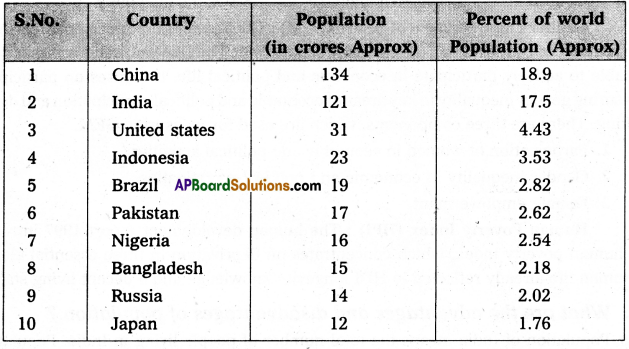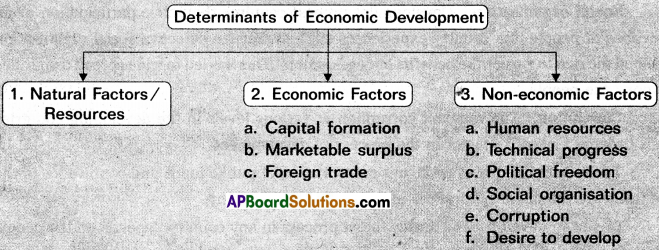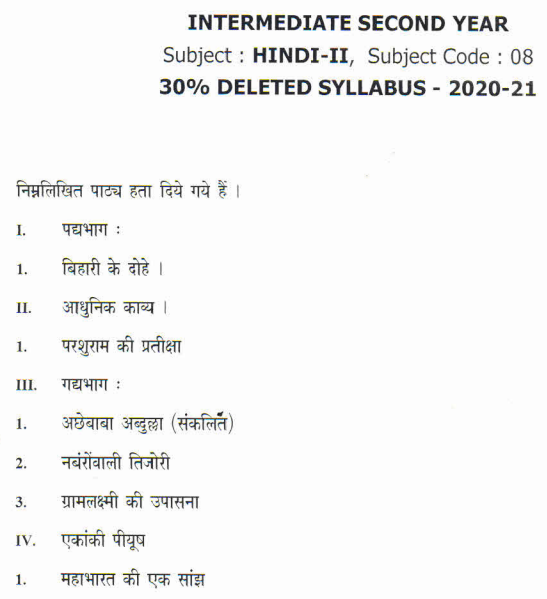Andhra Pradesh BIEAP AP Inter 2nd Year Economics Study Material 7th Lesson Planning and Economic Reforms Textbook Questions and Answers.
AP Inter 2nd Year Economics Study Material 7th Lesson Planning and Economic Reforms
Essay Questions
Question 1.
Define planning and what are the objectives of planning.
Answer:
There is no single opinion among economists with regard to the meaning of planning. From the economic growth point of view, planning stands for the actions taken during a particular period to achieve a targeted growth rate, economic planning implies deliberate control and direction of the economy by a central authority for the purpose of achieving definite targets and objectives within a specified period of time.
Thus planning means the efforts taken to reach the already set goals during a particular time period or directing the economic activities in a systematic way to get the set goals.
General objectives of planning :
- To increase the annual growth rate.
- Thereby, increasing the per capita income and standard of living of the people in the country.
- Speedy industrial development.
- Self-sufficiency with respect to the production of food grains.
- Removal of regional imbalances.
- Eradication of poverty by removing disparities in income and wealth.
- To increase the employment opportunities.
- To bring steady growth through price stabilisation.
![]()
Question 2.
Explain the objectives of Twelth five year plan. [A.P. Mar. 17, 18]
Answer:
The Government on 4th October approved the 12th five year plan (2012 – 2017) to achieve annual average economic growth rate of 8.2 per cent, down from 9 per cent envisaged earlier, in view of fragile global recovery. According to officials the projected average rate gross capital formation in the 12th plan is 37 per cent of GDP. The projected gross domestic savings rate is 34.2 per cent of GDP.
Main objectives :
The main objectives of twelth five year plan with its central aim faster, sustainable and more inclusive growth are discussed under the following heads.
a) Economic Growth :
- Real GDP Growth Rate of 8.0 per cent.
- The per capita income should grow at 6.5 per cent per annum.
- Agriculture growth rate of 4.0 per cent.
- 10 percent annual growth rate of manufacturing or industrial sector.
- Industrial sector growth rate of 7.6 percent.
- Service sector growth rate of 9.0 per cent.
- Every state must have a higher average growth rate in the Twelth plan than that achieved in the Eleventh plan.
b) Poverty and Employment:
- Head – Count ratio of consumption poverty to be reduced by 10 percentage points over the proceeding estimates by the end of twelth five year plan.
- Generate 50 million new work opportunities in the non-farm sector and provide skill certification to equivalent numbers during the twelth five year plan.
c) Education :
- Increase in literacy to 85 percent by 2017.
- Mean years of schoohng to increase to seven years by the end of twelth five year plan.
- Enhance access to higher education by creating two million additional seats for each age cohort aligned to the skill needs of the economy (RUSA).
- Eliminate gender and social gap in school enrollment (that is, between girls and boys, and between SCs, STs, Muslims and the rest of population) by the end of the twelth five year plan.
![]()
d) Health :
- Reduced IMR to 25 and MMR to 1 per 1000 live births, and improve child sex ratio (0-6 years) to 950 by the end of the twelth five year plan.
- The outlay on health would include increased spending in related areas of drinking water and sanitation.
- Reduce Total Fertility Rate to 2.1 by the end of Twelth five year plan.
- Reduce under nutrition among children aged 0-3 yrs to half of the NFHS – 3 levels by the end of the plan.
e) Infrastructure, Including Rural Infrastructure :
- Increase investment in infrastructure as a percentage of GDP to 9 percent.
- Increase the Gross Irrigated Area from 90 million hectare to 103 million hectare.
- Provide electricity to all villages and reduce AT & G losses to 20 percent by the end of twelth five year plan.
- Connect all villages with all weather roads by the end of twelth five year plan.
- Upgrade national and state highways to the minimum two – lane standard by the end of twelth five year plan.
- Complete Eastern and Western Dedicated Freight Corridors by the end of twelth five year plan.
- Increase rural tele – density to 70 percent.
- Ensure 50 percent of rural population has access to 55 LPCD piped drinking water supply and 50 percent of gram panchayats achieve the Nirmal Gram Status by the end of plan.
f) Environment and Sustainability:
- Increase in forest and tree cover to 33 percent.
- Increase green cover (as measured by satellite imagery) by 1 million hectare eveiy year during the twelth five year plan.
- Add 30,000 MW of renewable energy capacity in the plan.
- Reduce emission intensity of GDP in line with the target of 20 percent to 25 percent reduction by 2020 over 2005 levels.
- Cleaning of all major polluted rivers.
g) Service Delivery:
- Provide access to banking services to 90 percent Indian households by the end of the plan.
- Major subsidies and welfare related beneficiary payments to be shifted to a direct cash transfer by the end of the twelth plan, using the Aadhar platform with linked bank accounts.
Question 3.
Briefly review the achievements and failures of Eleven five year plans. [A.P. Mar. 18]
Answer:
Achievements :
- India attained self – sufficiency with regard to the food grain production increased from 50.8 million tonnes into 264 million tonnes.
- The growth rate in the national income increased from 3.6 percent in First plan to 8.3 percent by the end of 11 plan.
- The percapita income increased from ₹ 1.32 lakhs crores in the first plan to ₹ 47.67 lakh crores by the end of 11th plan. A considerable progress in progress in the production of various industries like steel, aluminium etc.
- Large scale development took place in infrastructural facilities like transportation irrigation tele communication etc.
- India attained commandable progress in science, technology and research.
- To control the increasing population, the family planning programme came into force for the first time in the sixth plan.
- The industrial growth increased from 32 million tones to 583 million tones by the end of 11th plan.
Failures of the plans: The Indian economy has made significant progress over more than fifty years of planning era. Still there are many weakness which point out towards the failures of Indian plans in many ways.
- Despite more than sixty years of planned economic development. Still there exist the problems of poverty and unemployment.
- Inspite of the several measures taken under land reforms. Still there exist inequalities with regard ownership of land. There is need for redistribution of land among the landless. So it can be said that the land reforms are not implemented properly.
- The plans are hot able to control the volume of black money and corruption.
- We are still have to go along way to reach the target of health to all.
- Plans are not been able to reduce the economic concentration of income and wealth in the few plans.
- Plans failed to achieved balanced regional development.
![]()
Question 4.
Explain the causes of regional imbalance in India. [A.P. Mar 16]
Answer:
Regional imbalances stand in the way of a nation’s integrity, economic growth and development. Before taking the measures to rectify regional imbalances, it is imperative to know the causes of regional imbalances. They are :
a) Geographical reasons : Physical geography controls economic growth in developing countries than the developed countries. For Ex: Himachal Pradesh, Hill districts of UP, Northern Kashmir etc., remained backward mainly because of in accessibility.
b) Climate condition : Climate too plays an important role in the economic development of many regions in India, regions with adverse climatic conditions reflected in low agricultural output and absence of large – scale industries.
c) British rule: Historically, the existence of backward regions started from the British rule in India. The British helped the development of only those regions which are. endowed with conductive facilities to drain Indian wealth to their country like Calcutta, Bombay etc.
d) Concentration of Industries: New investment, in the private sector has a tendency to concentrate in already well developed areas, thus reaping the benefits of external economics. Since, well developed area offers private investors certain basic advantages viz., skilled labour, infrastructure, transport etc.
e) Scarcity of Natural Resources : Certain regions are endowed with natural resources, whereas some regions are not. Those regions with great natural resource endowment are developed faster.
f) Lack of Infrastructural Facilities: Those regions where there are no proper roads, electricity, telecommunication, drinking water, education, medical, technical, training facility, credit facilities etc., they tend to remain underdeveloped.
Question 5.
Explain the measures taken for balanced regional development
Answer:
As the problem of regional imbalance is multidimensional and peculiar one, it is very difficult to bring balanced regional development. Though steps have been launched since second five year plan in this direction, still a lot is required to do. However, following things can be done to attain a balance between different regions.
- Transfer of funds from the central pool to backward states.
- Starting of industries by the Government in the backward regions, as private sector having bias towards developed regions.
- Providing infrastructural facilities like electricity, telecommunications, transport etc., in backward regions.
- Encouragement to industrial decentralization through regional planning and micro level planning.
- Formation of Industrial estates in backward areas.
- Special policies to the regions where frequent floods and drought occur.
- Central assistance to develop hill and tribal areas.
- Encouragement to small scale industries.
- Provision of subsidies, tax concessions, tax holidays etc.
![]()
Question 6.
Explain the role of International Trade in Economic Development.
Answer:
The role of international trade in economic development is significant. In modem days all countries irrespective of their financial status are depending in participating in international trade. Economists found a positive association between country’s participation in international trade and its level of economic growth.
a) Increases output: Due to international trade when a country specializes in the production of few goods and division of labour, it exports the commodities which it produces cheaper in exchange for what others can produce at lower cost. It gains from trade through increased output, national income which is useful to break vicious circle of poverty and promotes development.
b) Expand mairket: Developing countries are hampered by the small size of domestic markets which fail to absorb sufficient volume of output. This leads to low inducement to investment. International trade widens the market arid increases the inducement to invest.
c) Increases Employment : Due to international market opportunities, under – developed countries started exploiting unutilized resources which will reduce unemployment and under employment. As people’s income rises, domestic savings and investments increase. Human resources will be utilized optimally.
d) Increases Internal and External Economies : Expansion of productive activities and expanded market opportunities leads to a number of internal and external economies, and hence to reduction of cost of production. There are the direct gains from international trade.
e) Indirect Benefits : By enlarging the size of the market and the scope of specialization, international trade makes a greater use of machinery, encourages inventions and innovation and raises labour productivity.
f) Import of capital goods against export of staple commodities : International trade helps to exchange domestic goods having low growth potential for the foreign goods with high growth potential.
g) Important Educative Effect : International trade helps in importation of ideas, skills and technical know – how from the developed countries and stimulates technical progress in UDCs. So underdeveloped countries have to change their poor educational, technical, productive systems so as to raise their competitiveness.
h) Basis for importation of foreign capital: Developing countries are capital scarce economies. This condition restricts the economy in all fields to move ahead. If a country actively participates in international trade, the unused capital resources of rich countries will flow and utilized effectively in capital poor countries. Foreign capital not only helps in increasing employment, output and income but also smoothen the adverse balance of payments and inflationary pressures.
![]()
Question 7.
Define Globalization and what are the essential conditions of globalization in India.
Answer:
Globalization is the process of integrating or synchronizing domestic economy with the world economy or in simple words it is the process of opening up of domestic economy doors to the rest of the world.
Essential conditions for Globalization : There are some essential conditions to be satisfied on the domestic economy as well as the firm for successful globalization of the business. They are
a) Business Freedom : There should not be unnecessary government restrictions which come in the way of globalization. Like import restrictions, restrictions on sourcing finance, foreign investment etc. So, Liberalization is the pre condition for globalization.
b) Infrastructure facilities : The extent to which an enterprise and develop globally from home country base depends on the infrastructural facilities like water, transport, electricity, finance etc.
c) Government support : Although unnecessary government interference is a hindrance to globalization. Government support can encourage globalization. Government support may take the form of policy and procedural reforms, development of common facilities like infrastructural facilities.
d) Resources : Resources often decide the ability of a firm to globalize. Resourceful companies may find it easier to thrust ahead in the global market. Resources include finance, technology, R and D capabilities, managerial expertise etc.
e) Competitiveness : The competitive advantage of the company is an important determinant of success in global business. A firm may derive competitive advantage from any of the factors such as low costs and price, product quality, product differentiations, technological superiority etc.
f) Orientation : A global orientation on the part of the business firms and suitable globalization strategies are essential for globalization.
![]()
Question 8.
Explain the impact of globalization on Indian Economy.
Answer:
Globalization is the process of integrating or synchronizing domestic economy with the world economy or in simple words it is the process of opening up of domestic economy doors to the rest of the world.
Impact of Globalisation on Indian Economy :
a) India’s share in the world exports raised from 0.53 percent in 1991 to 1.7 percent by 2013.
b) Foreign currency reserves which were as low as one billion U.S dollars, grow up to 333 billion U.S dollars by the end of February 2015.
c) Exports now finance more than 65 percent of imports.
d) Control over country’s current account deficit is observed.
e) The growing rate of external debt decreased drastically when compared to prereform period. .
f) International confidence in India has been restored.
g) Indian consumers are now enjoying wide variety of quality goods at lower prices.
h) Employment situation worsened in the era of globalization. The growth rate of employment actually declined from 2 percent to 0.98 percent after globalization.
i) The pressure of MNCs, IMF and World Bank force governments to take decisions regarding reforms actually leading to the closure of small and medium enterprises.
j) Globalization also widened the income inequalities among the people and even among regions too.
Short Answer Questions
Question 1.
Types of planning.
Answer:
Economic planning is the main characteristic feature of socialistic and mixed economic systems, which fallow planned development strategy.
Types of planning:
a) Perspective plan : A perspective plan is a macro plan formulated for a period of 15 to 20 years, keeping in view the long term needs and long term objectives.
b) Five year plans: Five year plans are designed for a period of five years. A five year plan is an integral part of perspective plan. After the completion of five years, the achieved targets will be reviewed.
c) Annual plans : Annual plan is part of a five year plan. The targets of five year plans are divided into annual targets and detailed plans will be prepared year – wise.
d) Rolling plans : This concept was introduced by Gunnar Myrdal. This kind of plan does not have a fixed period of time. It has only duration and moves forward, the completed year will be deleted and next year will be added.
![]()
Question 2.
Planning commission.
Answer:
After independence on 1st March, 1950, the planning commission was setup by the Government of India. Planning Commission works independently and as an advisor to the central government. The Prime Minister of the country acts as the chairman and there will be an active deputy chairman and other members in the commission. Montek Singh Ahluwalia was its last Deputy Chairman. The cabinet minister of key portfolios also the ex-officio members. Experts in various fields like economics, industry, science and technology etc., will be appointed as full time members. From 1st January 2015, planning commission replaced by NITI Ayog.
Question 3.
Explain the objectives of planning commission. [A.P. Mar 17]
Answer:
Preparing plans for the most effective and balanced utilization of the country’s man power, physical and capital resources is the obligation of planning commission.
Objectives and functions:
- To make an assessment of the material, capital and human resources of the country and to examine whether they are sufficient to meet the nation’s requirement.
- To.define the stages, on the basis of priority in which the plan should be carried out and propose the allocation of resources for the due completion of each stage.
- To indicate the factors that tend to retard economic development and find feasible ways to overcome these factors.
- To determine the conditions for the successful execution of the’ plan.
- To determine the nature of the machinery required for securing the successful implementation of each stage of the plan in all its aspects.
- To appraise from time to time the progress achieved in the execution of each stage of the plan and to recommend alternative policy measures when they are needed.
![]()
Question 4.
Explain atleast three failures of plans.
Answer:
The Indian economy has made significant progress over more than sixty five years of planning era. Still there are many weaknesses which point out towards the failures of Indian plans in many ways. Some of the failures are presented as under.
a) Despite more than sixty years of planned economic development, still there exist the problems of poverty and unemployment. In 2012 the Indian government stated 21.9 percent of its population is below its official poverty limit. (About 300 million people), like wise the from 1983 till 2011 unemployment rates in India averaged 9 percent reaching an all time low of 3.8 percent in December 2011. The NSS data reveals the number of unemployed to be of the order of 26.58 million during 1999 – 2000 and 28.1 million during 2009-10.
b) Inspite of the several measures taken under land reforms, still there exist inequalities regarding land, income and wealth. Distribution of surplus lands not completed.
c) One of the objectives of Indian Five Years Plans was to establish an egalitarian society. This could not be achieved so far.
d) The plans are not able to control the volume of black money and corruption. In Feb 2012 Central Bureau of Investigation (CBI) said that Indian have $ 500 billion illegal money (Black money) based on a statement made to India’s Supreme Court in July 2011.
e) We still have to go a long way to reach the target of Health to All.
Question 5.
Causes of Regional Imbalances in India. [A.P. Mar. 18, 17]
Answer:
Regional imbalances stand in the way of Nation’s Integrity, economic growth and development.
a) Geographical Reasons : Physical geography controls economic growth in developing countries than the developed countries. For example, Himachal Pradesh, Hill district of UP, Northern Kashmir etc., remained backward mainly because of inaccessibility.
b) Climatic Conditions : Climate too plays an important role in the economic development of many region in India, region with achierse climatic conditions reflected in low agricultural output and absence of large – scale industries.
c) British Rule : Historically the existence of backward regions started from the British rule in India. The British helped the developed of only those regions which are endowed with conducive facilities to drain Indian wealth to their country like Calcutta, Bombay etc.
d) Concentration of Industries: New investment, in the private sector has attendance to concentrate in already well developed areas, thus reaping the benefits of external economic. Since, well developed area offers private investors certain basic advantages viz., skilled labour, infrastructure, transport etc.
e) Scarcity of Natural Resources : Certain regions are endowed with natural resources, where as same regions are not. Those regions with great natural resources endowment are developed faster.
f) Lack of Infrastructural Facilities: Those regions where there are no proper roads, electricity, telecommunication, drinking water, education, medical, technical training facility etc., tend to remain underdeveloped.
![]()
Question 6.
Enumerate 3 points in justification of privatization.
Answer:
1) Improvement in efficiency and performance : The Private sector introduces the profit oriented decision making process in the working of enterprise leading to improved efficiency and performance.
2) Fixing Responsibility is Easier : While personnel in the public enterprises cannot be held responsible for any lapse, the areas of responsibility in the private sector is clearly defined. This makes it possible to take people to task in the private sector units for blunders committed by them, whereas in the public sector units, it is easy to pass the buck.
3) Private units are subject to capital market discipline : Private sector firms are subject to capital market discipline and scrutiny by financial experts. In fact, the ability to raise funds in the capital market is critically dependent on performance, but not so in the case of public enterprises.
Question 7.
Rule of International Trade.
Answer:
The international trade plays avery vital role for the development of economic of the developing countries.
1) Due to international trade when a country specializes in the production of few goods and divisions of labour, it exports the commodities which it produces cheaper in exchange for what others can produce at lower cost.
2) Developing countries are hampered by the small size of domestic markets which fail to absorb sufficient volume of output. This leads to low inducement to investment. International trade widens the market and increases the inducement to invest.
3) Due to international market opportunities, under developed countries started exploiting unutilized resources which will reduce unemployment and under employment.
4) Expansion of productive activities and expanded market opportunities leads to a number of internal and external economics, and hence to reduction of cost of production.
5) By enlarging the size of the market and the scope of specialization, international trade makes a greater, use of machinery, encouraging inventions and innovation and raises labour productivity.
6) International trade helps to exchange domestic goods having low growth potential for the foreign goods with high growth potential.
7) International trade helps in importation of ideas, skills and technical know-how from the developed countries and stimulates technical progress in UDCs.
8) Developing countries are capital scarce economics. If a country actively participates in international trade, the unused capital resources of rich countries will fallow and utilized effectively in capital poor countries.
![]()
Question 8.
Objectives of GATT.
Answer:
- It had no legal status.
- It was not created by the governments and legislatures.
- It was not an agency of the United Nations Organization.
- It has a set of rules and producers relating to multilateral agreements of selective nature. There were separate agreements on on members.
- The GATT disputes settlements system was dilatory and not binding on the parties to the disputes
- The GATT was a forum where the member countries meet once in a decade to discuss and solve world trade problems.
- The GATT rules applied to trade in goods.
- It has a small secretariat managed by a Director General.
Question 9.
Objectives of W.T.O
Answer:
a) It aims at raising standard of living, ensuring full employment and large and steady growth, expanding the production and trade in goods and services among the global countries.
b) To allow for the optimal use of the world’s resources in accordance with the objectives of sustainable development. This also considers environmental protection with economic growth.
c) To ensure the developing and least developed countries secure a share in the growth in international trade.
d) To convince the member countries for reciprocal and mutually advantageous arrangements through reduction of tariffs and other trade harries.
e) To develop an integrated, more viable and durable multilateral trading system.
Question 10.
Differences between GATT and WTO.
Answer:
GATT
- It had no legal status.
- It was not created by the government and legislatures.
- It was not an agency of the united nations organization.
- It has a set of rules and procedures relating to multilateral agreements of selective nature. There were.separate agreements on separate issues which were not binding on members. Any member could stay out of an agreement. Only could be penalized on default.
- The GAIT disputes settlement system was dilatory and not binding on the parties to the disputes.
- The GATT was a forum where the member countries met once in a decade to discuss and solve world trade problems.
- The GAIT rules applied to trade in goods.
- It has a small secretariat managed by a Director General.
WTO
- It has legal status.
- It has been created by international treaty ratified by the governments and legislatures of the member states.
- It has co-operative relationship with the UNO. The agreements which form part of the WTO are permanent and binding on all members.
- Action can be taken against any defaulting member by all the member states.
- The WTO dispute settlement mechanism is automatic, faster and binding on the parties.
- Its properly established rule based World Trade Organisation where decisions on agreements are time bound.
- The WTO covers not only trade in goods and services but also trade related aspects of intellectual property rights and number of other agreements.
- It has a large secretariat and a huge organizational set-up.
![]()
Question 11.
Functions of W.T.O [A.P. Mar. 18, 16]
Answer:
a) WT.O facilitates the implementation, administration and operation of world trade agreements.
b) It provides the forum for trade negotiations among its member countries.
c) It shall handle trade disputes.
d) It shall monitor national trade policies of member countries.
e) It shall provide technical assistance and training to developing countries.
f) It maintains harmonious and co-operative relationship with IMF and IBRD and its affiliated agencies.
Very Short Answer Questions
Question 1.
Define plan.
Answer:
Plan may be defined as an outline or broad statement of schemes Or programmes designed or evolved to relaise certain pre-determined economic objectives.
(Or)
The efforts taken to reach the already set gains during a particular time period.
Question 2.
What is Rolling plan ?
Answer:
Rolling Plan : This concept was introduced by Yunnar Myrdal. This kind of plan does not have a fixed period of time. It has only duration and moves forward, the completed year will be deleted and next year will be added.
![]()
Question 3.
Concept of plan holiday.
Answer:
The gap that occurred in the planning process. There was official gap was 1966 – 69. A unofficial gap occurred in 1990 – 92 due to economic and political instability in the country.
Question 4.
Define perspective plan.
Answer:
A perspective plan is a macro plan formulated for a period of 15 to 20 years. Keeping in view the long term needs and long term objectives.
Question 5.
What is an Annual plan ? Give an example.
Answer:
Annual plan is a part of five year plan. The targets of five year plans are divided into annual targets and detailed plans will be prepared year – wise.
For example : There was a plan holiday for three years from 1966 – 69 at that time annual plans are implemented by postponing the commencement of 4th plan.
Question 6.
Backward states in India.
Answer:
We can classify the states in India into two categories on the basis of percapita income. Poverty and Human development index. They are 1. Developed states 2. Developing states Backward states are Orissa, Bihar, Utter Pradesh, Madhya Pradesh and Assam.
Question 7.
Define Regional imbalance.
Answer:
The co-existence of relatively developed and economically depressed states and even regions with each country or state is known as regional imbalance. It may be natural or mammal.
![]()
Question 8.
Balanced regional development.
Answer:
It implies the extension of the economic progress to the backward area and widespread diffusion of industry. It does not mean equal development of the different regions in the country. The objective is to raise the standard of living of the people into backward regions.
Question 9.
What is Liberalisation ?
Answer:
It refers to relaxation of previous government restrictions usually in areas of social and economic policies. Thus, when government liberalised trade it means it has removed the tariff, subsidies and other under employment restrictions on the flow of goods and services between the countries.
Question 10.
Explain the concept of privatization.
Answer:
It is the general process of involving the private sector in the ownership or operation of a state owned enterprises. Privatisation is a process the government transfers the producing activity from the public sector to the private sector.
Question 11.
Define Globalisation. [A.P. Mar. 18]
Answer:
It is the process of integrating various economies of the world without creating any hindrance in the free flow of goods and services, technology, capital even labour or human capital.
Question 12.
Concepts of TRIPS.
Answer:
Trips refer to the legal ownership by a person or business of an invention attached to a particular product.
Question 13.
What do you mean by TRIMS ?
Answer:
Trade related investment measures refer to certain condition or restrictions imposed by a Governments is respect of foreign investment in the country. TRIMS were widely employed by developing countries. The agreement or trade. Related investment measures calls for introducing national treatment of foreign investment.
![]()
Question 14.
The clause of MFN. [A.P. Mar. 16]
Answer:
Any concession given to any nation was automatically extended to all the member countries of the GATT. MFN means Most Favoured Nation.
Question 15.
Define Disinvestment.
Answer:
The sale of the public sector equity to the private sector is called disinvestment.
Question 16.
GATT.
Answer:
The general agreement on Tariffs and trade it came into force on 1st January 1948. As the name itself suggests, General Agreement was concerned only with tariffs and trade restrictions and regulated international trade matters. Geneva is the head quarter of GATT.
Question 17.
W.T.O. [A.P. Mar. 17]
Answer:
The WTO Agreement came into force from January 1, 1995. WTO is a new international organisation setup as a permanent body and is designed to play the role of a watch dog in the spheres of trade in goods, trade in services, foreign investment, intellectual property rights etc.
![]()
Question 18.
Uruguay Round.
Answer:
There were 8 rounds of negotiations between participating countries. In GATT in 1947. The 1st six rounds were related to curtailing tariff rates. Seventh-round included non-tariff obstacles. 8th round is different from previous round. Because it included a number of new objects for consideration, this 8th round known as “Uruguay Round’.
Question 19.
F.D.I.
Answer:
Investment in a foreign country where the investor remains control over the investment. FDI means foreign direct investment.
